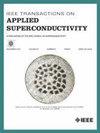Mechanical Performance and Deformation of HTS Cable With Cyclic Electromagnetic Thermal Coupling Process
IF 1.7
3区 物理与天体物理
Q3 ENGINEERING, ELECTRICAL & ELECTRONIC
引用次数: 0
Abstract
To cope with various superconducting applications, the superconducting tapes in high-temperature superconducting (HTS) cables adopt different winding methods considering material properties and electromagnetic performance. AC or DC HTS power transmission cables used in large quantities are usually spirally wound, and the superconducting tape is stressed during the winding process. To evaluate the influence of electromagnetic factors and contact forces on HTS tapes in the cable generated by electromagnetic field and temperature variation, a theoretical analysis of the stress on the superconducting tape and HTS cable is performed. Based on the electromagnetic-thermal coupling finite element analysis model, MATLAB/COMSOL is used to jointly simulate the stress and strain conditions. The COMSOL electromagnetic-thermal model outputs electromagnetic and temperature parameters for stress and strain simulation. After mechanical simulation, the resulting changes in geometric parameters will be returned to the electromagnetic-thermal model. In this process, the critical current of tapes is affected by the magnetic field, temperature, and stress and is updated iteratively between models. The coupling model established in this study can be used to analyze mechanical performance of HTS cables under overcurrent and overtemperature conditions with different cases such as aircraft electrical power transmission, as well as to evaluate short-term safety and long-term reliability in the future.循环电磁热耦合高温超导电缆的力学性能与变形
为了应对各种超导应用,高温超导电缆中的超导带根据材料特性和电磁性能的不同,采用不同的缠绕方式。大量使用的交流或直流高温超导输电电缆通常采用螺旋绕线方式,超导胶带在绕线过程中受到应力。为了评估电磁场和温度变化对电缆中高温超导胶带产生的电磁因素和接触力的影响,对超导胶带和高温超导电缆的应力进行了理论分析。在电磁-热耦合有限元分析模型的基础上,利用MATLAB/COMSOL对应力应变条件进行了联合仿真。COMSOL电磁-热模型输出电磁和温度参数,用于应力和应变模拟。力学模拟后,几何参数的变化将返回到电磁-热模型中。在此过程中,胶带的临界电流受到磁场、温度和应力的影响,并在不同的模型之间迭代更新。本研究建立的耦合模型可用于分析飞机电力传输等不同情况下高温超导电缆过流和过温工况下的力学性能,以及未来对其短期安全性和长期可靠性的评估。
本文章由计算机程序翻译,如有差异,请以英文原文为准。
求助全文
约1分钟内获得全文
求助全文
来源期刊

IEEE Transactions on Applied Superconductivity
工程技术-工程:电子与电气
CiteScore
3.50
自引率
33.30%
发文量
650
审稿时长
2.3 months
期刊介绍:
IEEE Transactions on Applied Superconductivity (TAS) contains articles on the applications of superconductivity and other relevant technology. Electronic applications include analog and digital circuits employing thin films and active devices such as Josephson junctions. Large scale applications include magnets for power applications such as motors and generators, for magnetic resonance, for accelerators, and cable applications such as power transmission.
 求助内容:
求助内容: 应助结果提醒方式:
应助结果提醒方式:


